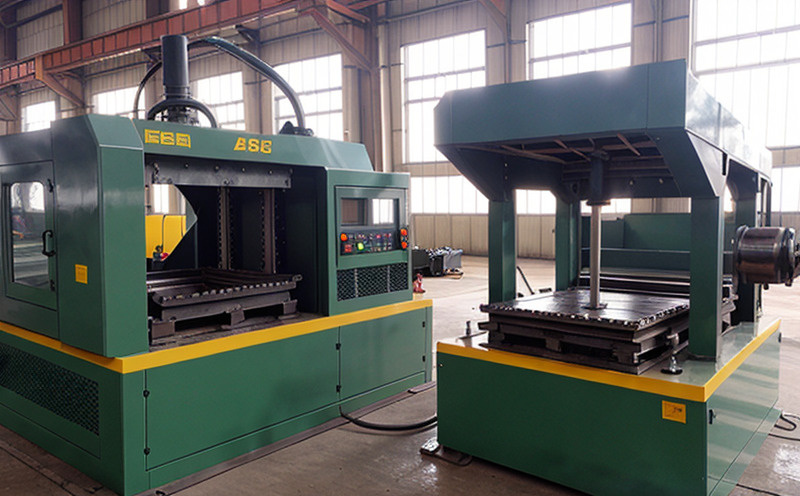ISO 7438 Bend Testing of Forged and Formed Metals
The ISO 7438 standard provides a precise method to evaluate the bend properties of forged and formed metals, ensuring that materials meet the necessary mechanical performance requirements. This test is crucial for industries where material integrity directly impacts product safety and reliability.
Bend testing is particularly important in sectors like automotive, aerospace, and manufacturing, where components must withstand high stresses without failure. By subjecting specimens to a defined bend angle and measuring their response, the ISO 7438 standard allows engineers to assess the ductility of metals under stress. This helps identify potential weaknesses that could lead to product failures.
The testing process involves placing a specimen between two flat anvils with a specified radius. The specimen is then bent around these anvils until it reaches a predetermined angle or deflection. The test results are compared against the specifications set out in ISO 7438, which provides detailed guidelines on specimen preparation, testing conditions, and acceptable limits.
For accurate results, specimens must be carefully prepared according to the standard’s requirements. This includes ensuring that any heat treatment or machining does not alter the mechanical properties of the material. The bend test is particularly useful for evaluating the ductility of materials such as carbon steel, stainless steel, and aluminum alloys.
The ISO 7438 standard ensures consistency across different laboratories by providing clear instructions on how to perform the test. This is essential in industries where compliance with international standards is critical. For example, aerospace manufacturers must ensure that all components meet strict quality requirements, as a failure could have severe consequences.
The bend test results can be used to determine whether materials are suitable for specific applications. For instance, a component made from a material that does not pass the ISO 7438 test may need to undergo additional heat treatment or other modifications before it is deemed fit for use. This ensures that only high-quality materials reach the manufacturing process.
In conclusion, ISO 7438 bend testing plays a vital role in ensuring material integrity and reliability. By adhering to this standard, manufacturers can produce components that meet stringent quality requirements, thereby enhancing product safety and performance.
Why Choose This Test
The ISO 7438 bend test is a critical tool for ensuring the mechanical integrity of forged and formed metals used in various industrial applications. By choosing this test, manufacturers can gain several key advantages:
- Consistency Across Laboratories: The standard provides detailed instructions on how to perform the test, ensuring that results are consistent regardless of the laboratory.
- Compliance with International Standards: By adhering to ISO 7438, manufacturers can ensure their products meet international quality standards, which is essential for global trade.
- Enhanced Product Safety: The test helps identify potential weaknesses in materials before they are used in critical applications, enhancing overall product safety.
- Improved Material Selection: By using this test, manufacturers can select the most suitable materials for their products, ensuring optimal performance and longevity.
The ISO 7438 bend test is a valuable asset for quality managers, compliance officers, R&D engineers, and procurement teams. It provides a robust framework for evaluating material properties, ensuring that only high-quality components reach the manufacturing process.
Quality and Reliability Assurance
The ISO 7438 bend test is an essential component of quality and reliability assurance programs. By using this standard, manufacturers can ensure that their products meet the necessary mechanical performance requirements, thereby enhancing product safety and reliability.
The test helps identify potential weaknesses in materials before they are used in critical applications. This ensures that only high-quality components reach the manufacturing process, reducing the risk of product failures. For example, a component made from a material that does not pass the ISO 7438 test may need to undergo additional heat treatment or other modifications before it is deemed fit for use.
In industries like automotive and aerospace, where product safety and reliability are paramount, the ISO 7438 bend test plays a crucial role. By adhering to this standard, manufacturers can produce components that meet strict quality requirements, thereby enhancing overall product performance.
The test results can be used to determine whether materials are suitable for specific applications. For instance, a component made from a material that does not pass the ISO 7438 test may need to undergo additional heat treatment or other modifications before it is deemed fit for use. This ensures that only high-quality materials reach the manufacturing process.
In conclusion, the ISO 7438 bend test is an essential tool for ensuring material integrity and reliability. By adhering to this standard, manufacturers can produce components that meet stringent quality requirements, thereby enhancing product safety and performance.
Competitive Advantage and Market Impact
- Enhanced Product Quality: By adhering to ISO 7438, manufacturers can produce high-quality components that meet international standards. This enhances product quality and reliability.
- Increased Customer Satisfaction: Customers appreciate products that are made from materials that have passed rigorous testing, leading to increased customer satisfaction.
- Competitive Edge in the Market: By ensuring high-quality components, manufacturers can gain a competitive edge in the market. This is particularly important in industries like automotive and aerospace, where product safety and reliability are paramount.
- Better Resource Utilization: The ISO 7438 bend test helps identify potential weaknesses in materials before they are used in critical applications. This ensures that only high-quality components reach the manufacturing process, reducing waste and improving resource utilization.
The ISO 7438 bend test is a valuable asset for quality managers, compliance officers, R&D engineers, and procurement teams. It provides a robust framework for evaluating material properties, ensuring that only high-quality components reach the manufacturing process.





